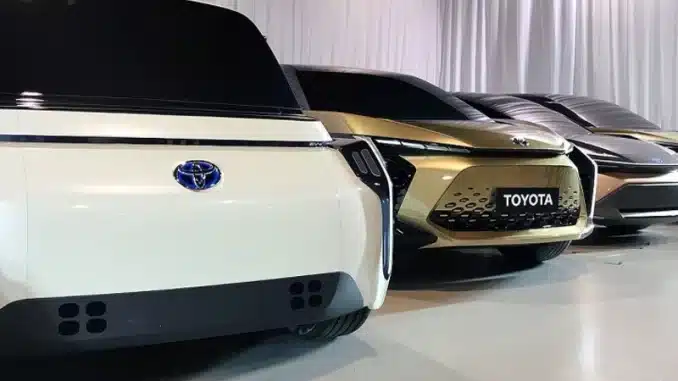
Toyota as of late declared it had passed the benchmark of having constructed in excess of 300 million vehicles since the organization was established a long time back. Yet, in spite of having spearheaded cross breed powertrains, the organization’s significant level suspicion towards EVs implies that not many of those vehicles have been completely electric; the Toyota bZ4X and Lexus RZ450e have gone on special in the barely a year ago. It is one of the last significant automakers to enter the EV space.
Yet, following the appearance of new President Koji Sato, Toyota has decisively expanded its obligation to electrics, with the point being to get rivals with a rush of new models and creative battery innovation.
One of the primary new EVs will be a three-line SUV (presented over) that is set to be delivered at Toyota’s Georgetown, Kentucky, plant from 2025, and which will be focused on a similar piece of the market as the Kia EV9. Toyota says this new model will utilize batteries created in its own production line in Freedom, North Carolina, a plant that as of now utilizes 2000 individuals however is set to increment to 5000.
By 2030 Toyota says it will actually want to make 30 GWh of batteries in North Carolina every year, enough for 375,000 80.0-kWh packs, however with creation split across 10 distinct lines to deliver different-sized packs for EV and module half breed models. There will be four different lines making straight mixture packs, and we can securely wager that by far most of Toyota creation, and potentially every last bit of it, will be hybridized by then.
Toyota says it is focused on making 3.5 million EVs every year by 2030, with 30 unique models across Toyota and Lexus brands. It is clear countless those will be delivered in the States.
Toyota’s battery innovation is likewise going to grow rapidly, with additional subtleties shared during a new visit C/D made to Toyota’s Shimoyama designing focus in Japan. The main advancement will be the one guaranteed by the Toyota FT-Se and Lexus LF-ZC ideas that were displayed at the current year’s Tokyo car expo: a super smaller elite presentation cutting edge lithium-particle battery that will actually want to sit under the floors of roadsters and cars without adding over the top level. In their least design, Toyota engineers say that the battery pack will be simply 3.9 inches tall, something made conceivable to a limited extent by side-mounted as opposed to top-mounted terminals.
Quick Charging, 400-Mile Batteries . . .
This exhibition pack will initially be utilized in 2026, with Toyota saying it will be 20% less expensive to deliver than the bZ4X’s pack, yet additionally that it will permit a 10 to 80 percent quick charge season of close to 20 minutes. ( The designers we addressed likewise proposed it will have a 900-volt engineering.) In its biggest design, and in the most effective vehicle, this exhibition pack will give north of 400 miles of EPA range. ( All reach figures in the above picture are cited accepting the more liberal WLTP standard, however EPA range figures are ordinarily around 15% lower, so we’ve changed Toyota’s cases descending as needs be to make them similar to those of different EVs sold in the U.S.)
. . . furthermore, Less expensive, Space-Effective Batteries
A less expensive cutting edge pack will follow without further ado subsequently that is expected for cheaper models and utilizing lithium-iron-phosphate battery (LFP) science as well as a creative bipolar inner plan. While a regular monopolar battery utilizes separate cathode and anode components, bipolar consolidates cathode and anode on an extraordinarily planned current gatherer, making it more space-productive and permitting more prominent energy thickness. Toyota says this first bipolar pack will be 40% less expensive than the bX4X’s battery and have around a 30-minute quick charge speed, giving around 315 miles of reach in its greatest setup.
An elite exhibition bipolar pack will continue in 2027, changing back to lithium-particle science and a high nickel cathode, with this being the one that Toyota says will eventually follow through on its case of a 520-mile driving reach. It will likewise be 10% less expensive than the presentation battery and will have a 20-minute 10-to-80-percent re-energize time under the most ideal circumstances.
The Anxiously Anticipated Strong State Battery (in 2027)
Past that, Toyota affirms plans to present strong state batteries when 2027, despite the fact that we note that the date has previously slipped from the 2025 that was being cited the year before. Strong state batteries utilize strong instead of fluid electrolytes, taking into consideration a more prominent resistance of high voltages and temperatures and further developing energy thickness and diminishing weight. The difficulties are intricacy, cost, and the trouble in conveying long haul toughness. Toyota says its first-gen strong state packs are focusing around 520 miles of reach, with a 10-minute 10-to-80 charge capacity, yet additionally says that ensuing development will probably move top reach up to 630 miles. That figure that would doubtlessly be sufficient to convince even the most resolved EV skeptic that long excursions can be achieved electrically.
Should Toyota follow through on this large number of cases — and it’s anything but a brand given to overpromising — then, at that point, it will be going from the rear of the pack on charge right to the forefront. We positively can’t blame the organization for any absence of desire, with the expressed expect to create 3.5 million EVs every year across 30 different Toyota and Lexus model lines by 2030.
Leave a Reply